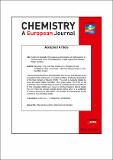Control of spatially homogeneous distribution of heteroatoms to produce red TiO2 photocatalyst for visible-light photocatalytic water splitting
Abstract
The strong band-to-band absorption of photocatalysts spanning the whole visible light region (400-700 nm) is critically important for solar-driven photocatalysis. Although it is actively and widely used as photocatalyst for various reactions in the past four decades, TiO2 has a very poor ability to capture the whole-spectrum visible light. Here, by controlling the spatially homogeneous distribution of boron and nitrogen heteroatoms in anatase TiO2 microspheres with a predominance of high-energy {001} facets, a strong visible light absorption spectrum with a sharp edge beyond 680 nm is achieved. The red TiO2 with the homogeneous doping of boron and nitrogen obtained shows no increase in defects like Ti3+ that are commonly observed in doped TiO2. More importantly, it has the ability to induce photocatalytic water oxidation to produce oxygen under the irradiation of visible light beyond 550 nm and also photocatalytic reducing water to produce hydrogen under visible light. These results demonstrate the great promise of using the red TiO2 for visible light photocatalytic water splitting and also provide an attractive strategy for realizing the wide-spectrum visible light absorption of wide-bandgap oxide photocatalysts.
Citation
Hong , X , Tan , J , Zhu , H , Feng , N , Yang , Y , Irvine , J , Wang , L , Liu , G & Cheng , H-M 2019 , ' Control of spatially homogeneous distribution of heteroatoms to produce red TiO 2 photocatalyst for visible-light photocatalytic water splitting ' , Chemistry - A European Journal , vol. Early View . https://doi.org/10.1002/chem.201805283
Publication
Chemistry - A European Journal
Status
Peer reviewed
ISSN
0947-6539Type
Journal article
Description
The authors thank National Natural Science Fundation of China (Nos. 51825204, 51572266, 21633009, 51629201), the Major Basic Research Program, Ministry of Science and Technology of China (2014CB239401), the Key Research Program of Frontier Sciences CAS (QYZDB-SSW-JSC039) for the financial support. G. L. is grateful for the award of the Newton Advanced Fellowship.Collections
Items in the St Andrews Research Repository are protected by copyright, with all rights reserved, unless otherwise indicated.

